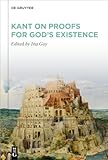Kant on Proofs for God’s Existence / ed. by Ina Goy.
Material type: TextPublisher: Berlin ; Boston : De Gruyter, [2023]Copyright date: ©2024Description: 1 online resource (XII, 310 p.)Content type:
TextPublisher: Berlin ; Boston : De Gruyter, [2023]Copyright date: ©2024Description: 1 online resource (XII, 310 p.)Content type: - 9783110688900
- 9783110689006
- 9783110688962
- 210.92 23/eng/20231215
- B2799.R4 K36 2024
- online - DeGruyter
- Issued also in print.
| Item type | Current library | Call number | URL | Status | Notes | Barcode | |
|---|---|---|---|---|---|---|---|
 eBook
eBook
|
Biblioteca "Angelicum" Pont. Univ. S.Tommaso d'Aquino Nuvola online | online - DeGruyter (Browse shelf(Opens below)) | Online access | Not for loan (Accesso limitato) | Accesso per gli utenti autorizzati / Access for authorized users | (dgr)9783110688962 |
Browsing Biblioteca "Angelicum" Pont. Univ. S.Tommaso d'Aquino shelves, Shelving location: Nuvola online Close shelf browser (Hides shelf browser)
Frontmatter -- Contents -- Citations and Abbreviations -- Introduction -- Part 1: The History of Proofs for God’s Existence in Kant’s Thought -- History and Theory of the Cosmos: The Role of God in Kant’s Universal Natural History and Theory of the Heavens (1755) -- Kant’s Panentheism: The Possibility Proof of 1763 and Its Fate in the Critical Period -- Proof and Belief: The Critique of Pure Reason on the Existence of God -- The Practical Proof in Kant’s Critique of Practical Reason -- Kant’s Moral Proof of the Existence of God in the Third Critique -- Kant’s Moral Argument and the Problem of Evil: Authentic Theodicy and the Sincerity of Faith -- Reason’s Need for God’s Actual Existence in Kant’s Religion -- Kant on Proofs of God’s Existence in the Opus postumum (1796–1804) -- Part 2: A Classification of Kant’s Proofs for God’s Existence -- Kant on Divine Artistry in Nature. Variants of the Physico-theological Argument -- Kant on ‘the Cosmological Argument’ -- Kant on the Ontological Proof -- Kant’s Moral Argument for Belief in God -- Bibliography -- Contributers -- Index of Names -- Index of Subjects
restricted access online access with authorization star
http://purl.org/coar/access_right/c_16ec
This volume provides a highly needed, comprehensive analysis of Kant's views on proofs for God's existence and explains the radical turns of Kant's accounts. In the "Theory of Heavens" (1755), Kant intended to harmonize the Newtonian laws of motion with a physicotheological argument for the existence of God. But only a few years later, in the "Ground of Proof" essay (1763), Kant defended an ontological ('possibility' or 'modal') argument on the basis of its logical exactitude. Nevertheless he continued to praise the physicotheological argument. In the first "Critique" (1781/7), Kant replaced the traditional constitutive proofs with regulative theoretical and practical arguments. He continued to defend a moral argument in the second "Critique" (1788). But in the third "Critique" (1790), Kant reintroduced a physicotheological besides an ethicotheological argument in order to unify the critical system of philosophy. Kant developed further moral arguments in the "Theodicy" essay (1791) and the "Religion" (1793/4), and still continued to discuss proofs for God's existence in the "OP" (1796–1804). This volume speaks to Kant specialists in the fields of philosophy and theology, but can be used also as an introduction for non-academic readers.
Issued also in print.
Mode of access: Internet via World Wide Web.
In English.
Description based on online resource; title from PDF title page (publisher's Web site, viewed 02. Jun 2024)









